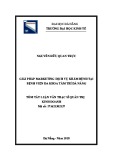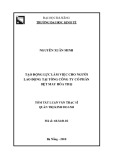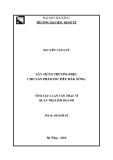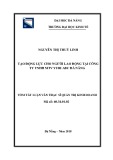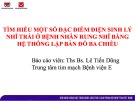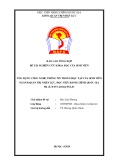
The Drosophila homeodomain transcription factor, Vnd,
associates with a variety of co-factors, is extensively
phosphorylated and forms multiple complexes in embryos
Huanqing Zhang
1,
*, Li-Jyun Syu
1,
, Vicky Modica
1
, Zhongxin Yu
1
, Tonia Von Ohlen
2
and
Dervla M. Mellerick
1
1 MSRBIII, Ann Arbor, MI, USA
2 Division of Biology, Kansas State University, Manhattan, KS, USA
The Drosophila homeodomain transcription factor,
Vnd, is the founding member of the Nk class of home-
odomain proteins, which are both necessary and suffi-
cient to specify ventral central nervous system (CNS)
cell fates in Drosophila embryos [1,2]. Drosophila neu-
roblasts are arranged in three columns, ventral, inter-
mediate and lateral, with the ventral cells juxtaposed
at either side of the ventral midline. Ventral column
identity is transformed to intermediate column identity
in vnd mutant embryos, whereas ectopic Vnd expres-
sion ventralizes the neuroectoderm [1,2]. Both mutant
analyses [1,3–5] and biochemical data [6,7] indicate
that Vnd functions as a dual regulator, capable of both
activating and repressing target gene expression. Vnd
interacts with the co-repressor, Groucho, to repress
target gene expression, whereas Vnd’s interaction with
the high mobility group (HMG) protein, Dichaete,
facilitates the activation of target genes [6,8]. However,
co-transfection analyses indicate that additional
unidentified co-factors are required to recapitulate the
robust regulatory effects of Vnd evident in embryos.
In this report, we further explore the biochemical
basis for Vnd’s capacity to function as a dual regula-
tor. We identify Drosophila Kc167 cells as an endoge-
nous source of Vnd and show that the co-repressor,
Groucho, physically interacts with Vnd in these cells.
Keywords
co-factor; complex; regulation; transcription;
Vnd
Correspondence
D. M. Mellerick, Med Sci I, M5240, Ann
Arbor, MI 48109-0602, USA
Fax: +1 734 369 3874
Tel: +1 734 709 3222
E-mail: dervlamellerick@yahoo.com
Present address
*5051 BSRB, Ann Arbor, MI, USA
1500 E. Medical Center Drive, Ann Arbor,
MI, USA
(Received 28 April 2008, revised 23 July
2008, accepted 12 August 2008)
doi:10.1111/j.1742-4658.2008.06639.x
Vnd is a dual transcriptional regulator that is essential for Drosophila dor-
sal–ventral patterning. Yet, our understanding of the biochemical basis for
its regulatory activity is limited. Consistent with Vnd’s ability to repress
target expression in embryos, endogenously expressed Vnd physically asso-
ciates with the co-repressor, Groucho, in Drosophila Kc167 cells. Vnd exists
as a single complex in Kc167 cells, in contrast with embryonic Vnd, which
forms multiple high-molecular-weight complexes. Unlike its vertebrate
homolog, Nkx2.2, full-length Vnd can bind its target in electrophoretic
mobility shift assay, suggesting that co-factor availability may influence
Vnd’s weak regulatory activity in transient transfections. We identify the
high mobility group 1-type protein, D1, and the novel helix–loop–helix
protein, Olig, as novel Vnd-interacting proteins using co-immunoprecipita-
tion assays. Furthermore, we demonstrate that both D1 and Olig are
co-expressed with Vnd during Drosophila embryogenesis, consistent with a
biological basis for this interaction. We also suggest that the phosphoryla-
tion state of Vnd influences its ability to interact with co-factors, because
Vnd is extensively phosphorylated in embryos and can be phosphorylated
by activated mitogen-activated protein kinase in vitro. These results high-
light the complexities of Vnd-mediated regulation.
Abbreviations
CNS, central nervous system; EMSA, electrophoretic mobility shift assay; Ets, erythroblast transformation-specific; HLH, helix–loop–helix;
HMG, high mobility group; MAP, mitogen-activated protein; UAS, upstream activating sequence.
5062 FEBS Journal 275 (2008) 5062–5073 ª2008 The Authors Journal compilation ª2008 FEBS






